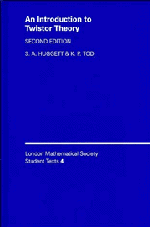Book contents
- Frontmatter
- Contents
- Preface
- Preface to the second edition
- 1 Introduction
- 2 Review of Tensor Algebra and Calculus
- 3 Lorentzian Spinors at a Point
- 4 Spinor Fields
- 5 Compactified Minkowski Space
- 6 The Geometry of Null Congruences
- 7 The Geometry of Twistor Space
- 8 Solving the Zero Rest Mass Equations I
- 9 Sheaf Cohomology and Free Fields
- 10 Solving the Zero Rest Mass Equations II
- 11 The Twisted Photon and Yang–Mills Constructions
- 12 The Non-Linear Graviton
- 13 Penrose's Quasi-Local Momentum and Angular Momentum
- 14 Functionals on Zero Rest Mass Fields
- 15 Further Developments and Conclusions
- 16 Hints, Solutions and Notes to the Exercises
- Appendix The GHP Equations
- Bibliography
- Index
Preface
Published online by Cambridge University Press: 25 January 2010
- Frontmatter
- Contents
- Preface
- Preface to the second edition
- 1 Introduction
- 2 Review of Tensor Algebra and Calculus
- 3 Lorentzian Spinors at a Point
- 4 Spinor Fields
- 5 Compactified Minkowski Space
- 6 The Geometry of Null Congruences
- 7 The Geometry of Twistor Space
- 8 Solving the Zero Rest Mass Equations I
- 9 Sheaf Cohomology and Free Fields
- 10 Solving the Zero Rest Mass Equations II
- 11 The Twisted Photon and Yang–Mills Constructions
- 12 The Non-Linear Graviton
- 13 Penrose's Quasi-Local Momentum and Angular Momentum
- 14 Functionals on Zero Rest Mass Fields
- 15 Further Developments and Conclusions
- 16 Hints, Solutions and Notes to the Exercises
- Appendix The GHP Equations
- Bibliography
- Index
Summary
This book is an introduction to Twistor Theory and modern geometrical approaches to space-time structure at the graduate or advanced undergraduate level. The choice of material presented has evolved from graduate lectures given in London and Oxford and we have aimed to retain the informal tone of those lectures.
Topics covered include spinor algebrea and calculus; compactified Minkowski space; the geometry of null congruences; the geometry of twistor space; an informal account of sheaf cohomology sufficient to describe the twistor solution of the zero rest mass equations; the active twistor constructions which solve the self-dual Yang–Mills and Einstein equations; and Penrose's quasi-local-mass constructions. Exercises are included in the text and after most chapters.
The book will provide graduate students with an introduction to the literature of twistor theory, presupposing some knowledge of special relativity and differential geometry. It would also be of use for a short course on space-time structure independently of twistor theory. The physicist could be introduced gently to some of the mathematics which has proved useful in these areas, and the mathematician could be shown where sheaf cohomology and complex manifold theory can be used in physics.
It is a pleasure to acknowledge many useful discussions, comments and corrections from colleagues in London, Oxford and elsewhere. In particular a debt is due to Mike Eastwood, Andrew Hodges, Lane Hughston, Ted Newman, David Robinson, George Sparling, Richard Ward, Ronny Wells and Nick Woodhouse; we are grateful to Val Willoughby for typing the manuscript and dealing patiently with innumerable revisions; but above all we are indebted for teaching and inspiration to Roger Penrose.
- Type
- Chapter
- Information
- An Introduction to Twistor Theory , pp. ix - xPublisher: Cambridge University PressPrint publication year: 1994

